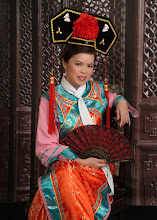

The nests of “grass swiftlets” (草燕) and “feathery swiftlets” (毛燕) just harvested are all very dirty and extremely smelly!!
No one would think of eating them. Now let’s take a look as to how people can actually transform them into something “edible”!!
刚采下来的草燕和毛燕都很肮脏,而且恶臭无比!!
根本不会有人想吃。现在就让我们带你去看看人们 怎样去把它们变成能吃的东西吧!!
The worker is removing the bigger pieces of feathers, grass and mud from the birds’ nests. 工人们正把草燕、毛燕上较大的毛、草、泥清除。


After removing the bigger pieces of feathers, grass, etc, she then cuts them into smaller pieces for further cleaning. 清除了杂粗毛、草后,再剪成小块继续清理。

Now, she soaks them so that the smaller pieces of debris can float in the water. 接着便浸炮以让较小的杂质浮上来。

Then, she soaks them in bleach for a few more hours, so that they all turn white… 再下来就是把它泡在漂白水里几个小时,直到全都变成白色了。。。

After the reaction, the bleach has changed colour… 漂白水经过反应后,颜色变得污浊了。。。

After the process of bleaching, she needs to use boiling water to remove the smell of the bleach… 漂白后,必须用热腾腾的沸水加以清洗,知道完全洗去漂白水的味道。。。


Now, it’s time to pick out those parts which cannot be bleached. 接下来就要挑出一些无法漂白的部分。




Now, it is time to transform these birds’ nests into something “edible”… 现在就是开始把毛、草燕加工成燕饼的时候了。。。




After moulding the broken pieces of the birds’ nests into nest shapes, she then parches them until dry. 把燕碎弄成燕饼的模型后,再进行烘干。






After one day and one night of drying, those pitiful birds’ nests have finally been transformed into these “edible” birds’ nests! 经过一天一夜的烘干后,终于把那堪入目的草、毛燕改造成这些燕饼。



Each year, Malaysia and Indonesia produce at least 800 – 2000 kg of these incredible birds’ nests. Each of these incredible birds’ nests contain very little truly edible birds’ saliva. But they are very dirty and almost completely black. No one would think of buying them to eat. Should they just be wasted? Of course not. There is surely a way to transform them into attractive products, and that is to bleach them. Some manufacturers use H2O2 to remove the smell on these birds’ nests, disregarding the fact that H2O2 contains poisonous chemicals that can cause cancer. It is also prohibited from adding into foods. Other manufacturers use SO2 and SO3 to remove the discolouration and debris from these birds’ nests, so as to obtain the purpose of bleaching them. SO2 and SO3 also contain poisonous chemicals. If taken in excess, they can also cause cancer. Very few foods are allowed to contain minute amounts of SO2 and SO3 (not more than two parts in a million). In Japan, all foods are not allowed to contain more than one part in a million of SO2 and SO3.
马来西亚及印尼每年生产的毛燕和草燕至少有800-2000KG。一盏草燕/毛燕,只有很少量的可食用燕窝(燕子口水),但都是很肮脏了, 几乎呈黑色。是没有人会买来吃的。难道就这样浪费掉吗? 不,当然有办法处理成吸引人的产品。就是将它漂白。一些供应商使用H2O2去除次等燕窝上的气味。H2O2是具有较强毒性的化学物质,且能致癌。是严格禁止添加在食品里的。还有一些供应商使用SO2和SO3去除次品燕窝上的杂乱颜色和杂质,达到漂白的目的。 SO2和SO3也是有毒化学物质。如果过量摄入也会致癌。极少食物里允许含少量的SO2和SO3(不能超过百万分之二)。在日本所有的食物里 SO2和SO3的含量都不允许超过百万分之一。
After Bleaching - From these: 漂白后,从这些:



=> To these: 变成了这些:



The nutritional value of these types of birds’ nests is already not that high in the first place. After these chemical processes, the nutrients in the nests have been completely destroyed. As such, it can be said to contain lesser nutrients than the snow fungus loved by the Chinese… Have you ever eaten them?
草燕和毛燕本身的营养已经不算高了,再经过这些化学物的处理,燕窝的营养已经完全被破坏了。所以,这些燕饼的营养成份可以说是比白木耳(银耳)还来得低了。。。你有吃过吗?
As these bleached birds’ nests have lost their original nest shapes, the manufacturers then mould them into different nest shapes. The most common ones are: leaf shaped, round shaped and longish shaped. Of course, there are those who give it an extra twist by adding yellow or reddish colours so as to bluff ignorant consumers and sell them as expensive “blood nests” (血燕) or “golden feathered nests” (金丝燕).
漂白了的草燕及毛燕由于没有了原来燕窝的盏形,商家们便把它制成不同形状的燕饼,最常见的有:叶子形状的,有条状的及圆形饼的。当然有些更把它们另外加工,染上黄色/红色的颜料来当血燕/金丝燕售卖。以欺骗贪小便宜的无知消费者。
Do you really think that people would ruin really good nests and sell them as invaluable stuff? Don’t be silly!!
The truth is that many bosses of many established and/or prestigious Chinese medicinal halls don’t even know what they are selling…
What more, the consumers? Of course, you may ask: “Are they not afraid of being sued by the consumer?” Of course not, as they are merely the distributors; and not the producers. Hence they do not need to bear the consequences.
SO now, do you still dare to buy those cheap birds’ nests?
你认为会有人将好好的燕窝盏破坏了再制成不值钱的东西来售卖吗?
别天真了!!
告诉你, 即使许多老字号中药行的老板, 都不知道自己卖的是什么东西。。。
更何况是消费者呢? 当然你可以问:“他们难道就不怕被消费者控告吗?”
当然不怕,因为他们只是代理,并不是生产家。所以不需承担后果。
现在, 你还敢买又便宜又多的燕饼吗?

No comments:
Post a Comment